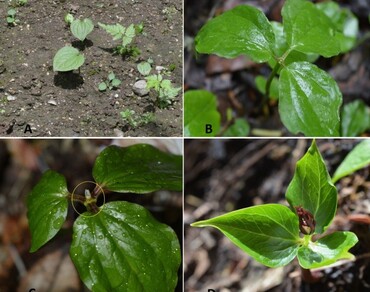Reproductive behavior of an endangered Himalayan medicinal herb Trillium govanianum Wall. ex D. Don
Chandola Vaishali, Chandra Sudeep, Kumar Rajeev Ranjan, Nautiyal A. R.
Research Articles | Published: 25 December, 2022
First Page: 1437
Last Page: 1445
Views: 3654
Keywords: n Trillium govanianumn , Emergence, Reproductive biology, Conservation, Seed dispersal
Abstract
The present study provides insights on the reproductive behavior of an important alpine medicinal herb, Trillium govanianum which is found growing in the Indian Himalayan states of Uttarakhand, Himachal Pradesh, Jammu and Kashmir and Sikkim. The study has been carried out at Tungnath India, which is a natural pocket of the herb. A significant difference of 35 ± 5 days has been observed in the emergence of the plant at an altitudinal gradient with an earlier emergence at the lower elevations providing an extended growth period to the plant. At elevations > 3500 masl or in the open meadows, the emergence was observed to be late with an earlier senescence. Breeding experiment revealed that plant favors both self as well as cross-fertilization and is ambophilous. Floral development starts within the unopened bud and anthesis takes place within a week of the opening of flower. Seed development and maturation is longest and occur in 3–4 months. Rhizomes of T. govanianum are harvested illegally before the onset of monsoon i.e. in early June, hampering seed production and dispersal. Therefore information on the phenological cycle and reproductive behavior and maturity of such species is an important step towards making policies for their conservation and further studies on their regeneration behavior.

References
Chauhan HK, Bisht AK (2020) Trillium govanianum. The IUCN Red List of Threatened Species 2020:e.T175804005A176257695. https://doi.org/10.2305/IUCN.UK.2020-3.RLTS.T175804005A176257695.en
Chauhan HK, Bisht AK, Bhatt ID, Bhatt A, Gallacher D, Santo A (2017) Population change of Trillium govanianum (Melanthiaceae) amid altered indigenous harvesting practices in the Indian Himalayas. J Ethnopharmacol 213:302–310. https://doi.org/10.1016/j.jep.2017.11.003
Dorji T, Hopping KA, Meng F, Wang S, Jiang L, Klein JA (2020) Impacts of climate change on flowering phenology and production in alpine plants: the importance of end of flowering. Agric Ecosyst Environ 291:106795. https://doi.org/10.1016/j.agee.2019.106795
Husaini AM (2010) Medicinal plants of the Himalayas: advances and insights. Global Science Books, Routledge
Kawano S (ed) (1994) World Trillium. Life history and evolution. Kaiyusha Publishing Company, Tokyo (in Japanese)
Korner C (2007) The use of ‘altitude’ in ecological research. Trends Ecol Evol 22:569–574. https://doi.org/10.1016/j.tree.2007.09.006
Moore LM, Lauenroth WK (2017) Differential effects of temperature and precipitation on early- vs. late-flowering species. Ecosphere 8:e01819. https://doi.org/10.1002/ecs2.1819
Mulik NG, Bhosale LJ (1989) Flowering phenology of the mangroves from the West Cost of Maharashtra. J Bombay Nat Hist Soc 3:355–359
Phillips NC, Drost DT, Varga WA, Shultz LM (2011) Demography, reproduction, and dormancy along altitudinal gradients in three intermountain Allium species with contrasting abundance and distribution. Flora 206:164–171. https://doi.org/10.1016/j.flora.2010.05.002
Pluess AR, Frei E, Kettle CJ, Hahn T, Ghazoul J (2011) Plant growth and fitness of Scabiosa columbaria under climate warming conditions. Plant Ecol Divers 4:379–389. https://doi.org/10.1080/17550874.2011.618848
Rahman SU, Ismail M, Khurram M, Haq IU (2015) Pharmacognostic and ethnomedicinal studies on Trillium govanianum. Pak J Bot 47:187–192
Rahman SU, Ismail M, Khurram M, Ullah I, Rabbi F, Iriti M (2017) Bioactive steroids and saponins of the genus Trillium. Molecules 22(12):2156
Sharma S, Sharma A, Mehta V, Chauhan RS, Malairaman U, Sood H (2016) Efficient hydroalcoholic extraction for highest diosgenin content from Trillium govanianum (Nag chhatri) and it’s in vitro anticancerous activity. Asian J Pharm Clin Res 9(4):386–392
Suzuki K, Kawano S (2010) Seed germination and dispersal strategy of Trillium apetalon (Trilliaceae): a typical temperate woodland perennial in Japan. Plant Species Biol 25:231–239. https://doi.org/10.1111/j.1442-1984.2010.00295.x
Rahman SU, Adhikari A, Ismail M, Shah MR, Khurram M, Shahid M et al (2016) Beneficial effects of Trillium govanianum rhizomes in pain and inflammation. Molecules 21:1095. https://doi.org/10.3390/molecules21081095
Verma S, Magotra R, Koul AK (2004) Stylar movement avoids self and promotes cross-pollination in Eremurus himalaicus. Curr Sci 87:872–873
Vidhyarthi S, Samant SS, Sharma P (2013) Dwindling status of Trillium govanianum Wall. ex D. Don—a case study from Kullu district of Himachal Pradesh, India. J Med Plants Res 7(8):392–397. https://doi.org/10.5897/JMPR12.622
Author Information
High Altitude Plant Physiology Research Center, H.N.B. Garhwal University, Srinagar, India